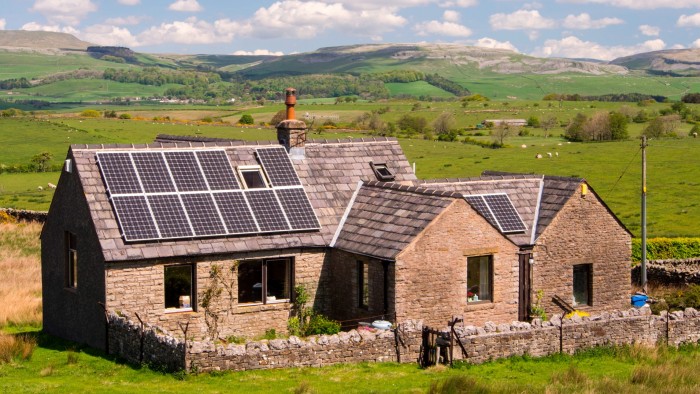Unlock the Editor’s Digest for free
Roula Khalaf, Editor of the FT, selects her favourite stories in this weekly newsletter.
UK lenders have pulled back from the green mortgage market, prompting questions over its role in Britain’s drive to decarbonise the economy.
Green mortgages now make up 11 per cent of the total available deals in the UK market, compared with 16 per cent in August 2023, according to analysis shared with the Financial Times by data group Moneyfacts.
It shows the number of total mortgage deals climbed to 6,992 as of this month, compared with 5,206 in August 2023, but the number of green offerings has fallen from 809 to 765 during the same period.
Green mortgages involve lenders offering preferential rates or cashback deals for buyers looking to purchase energy-efficient homes or make their existing home greener. Barclays was the first major lender to offer such a product in the UK in 2018.
Lenders, as well as regulators and the government, hope they will encourage homeowners to upgrade Britian’s draughty housing stock and help them meet their decarbonisation targets. Most homes are still heated with gas-fired boilers.
But their impact so far has been limited.
“Even with some high-street brands offering a green mortgage, the number of options continues to represent only a small fraction of the residential mortgage market as a whole,” said Rachel Springall at Moneyfactscompare.co.uk.
“Ultimately, lenders should look at pricing their products to encourage those people who are looking at a better EPC [energy performance certificate] rating on their property.”
The UK has one of the world’s oldest housing stocks, with few homes energy efficient. The average energy efficiency rating of homes in England and Wales is D on a scale of A to G. A is the most energy efficient rating.
Each lender defines its own rules as to what rating must be achieved to qualify for preferential rates or cashback deals.
The Moneyfacts data covers mortgage deals available to first-time buyers, second-time buyers and remortgage customers.
It does not include standard-variable rate products or more exclusive deals such as those for existing customers, shared equity or new-build. It also does not cover add-on products for existing customers seeking additional funds to improve the EPC rating of their property.
Its analysis shows the average rate for a two-year fixed green mortgage is currently 4.33 per cent, compared with 4.98 per cent across the market. That compares with 6.63 per cent and 6.76 per cent respectively in 2023.
David Hughes, mortgage adviser at The Mortgage Exchange, said there needed to be more collaboration between lenders and brokers to offer and promote greener products.
“The benefit to the client [is significant],” he added. “Energy bills down, mortgage payments down, but also putting the value of the house up considerably.”
Ian Bhullar, director of sustainability at trade group UK Finance, added: “The industry remains enthusiastic and committed to supporting the transition to energy-efficient homes, with lenders continuing to make green finance products available.
“However, low demand remains the key challenge. This momentum can only be sustained if the government provides clear and consistent support.”
He urged the government to set out how it will help “tackle the lack of demand for green home improvements and incentivise greener choices for homeowners”.
